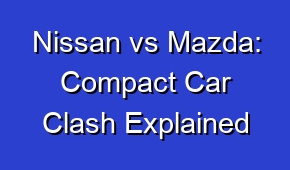Eco-Friendly Rides: Volvo vs Tesla Comparison

Get ready for the ultimate showdown between eco-friendly rides: Volvo vs Tesla. Discover which brand comes out on top in this faceoff, as we compare their sustainability features, performance, and overall environmental impact. Find out which electric vehicle is the better choice for the environmentally conscious driver.
When it comes to eco-friendly rides, the Volvo vs Tesla faceoff is one that cannot be ignored. Both car manufacturers have made significant strides in producing vehicles that prioritize sustainability and reduce carbon emissions. Volvo, known for its commitment to safety and innovation, has introduced a range of hybrid and electric models that offer impressive fuel efficiency and low environmental impact. On the other hand, Tesla, led by visionary entrepreneur Elon Musk, has revolutionized the electric car industry with its sleek designs and cutting-edge technology. With their advanced battery systems and long-range capabilities, Tesla cars have become synonymous with eco-friendly transportation. As consumers become increasingly conscious of their carbon footprint, the Volvo vs Tesla faceoff presents an intriguing choice for those seeking a greener way to travel.
| Eco-friendly rides: Volvo vs Tesla faceoff. |
| Volvo and Tesla are competing in the market for environmentally friendly vehicles. |
| Vehicles from Volvo and Tesla offer low or zero emissions, reducing environmental impact. |
| Tesla’s electric cars are known for their cutting-edge technology and long driving range. |
| Volvo is committed to sustainability and aims to have fully electric cars by 2030. |
- Tesla’s Model S is a luxury electric sedan with impressive acceleration and range.
- The Volvo XC40 Recharge is an SUV that offers all-electric driving with a sleek design.
- Tesla’s Supercharger network provides fast charging options for their electric vehicles.
- Volvo focuses on safety features and aims for zero fatalities in their cars by 2020.
- Tesla’s Autopilot feature offers advanced driver-assistance capabilities for a smoother ride.
Which is more eco-friendly: Volvo or Tesla?
When comparing the eco-friendliness of Volvo and Tesla, it’s important to consider various factors. Both companies have made significant efforts to produce electric vehicles that are more sustainable and environmentally friendly than traditional gasoline-powered cars.
| Emission of Greenhouse Gases | Production Process | Battery Recycling |
| Tesla produces zero-emission electric vehicles. | Volvo has committed to producing only electric vehicles by 2030. | Tesla has a battery recycling program to minimize waste. |
| Volvo vehicles emit greenhouse gases during their use. | Tesla’s production process focuses on reducing environmental impact. | Volvo also has a battery recycling program in place. |
| Tesla’s electric vehicles help reduce overall carbon footprint. | Both companies are working towards sustainable production methods. | Volvo aims to have 50% recycled materials in their cars by 2025. |
Tesla is known for its all-electric vehicles, which produce zero emissions while driving. They have a range of models available, from sedans to SUVs, and are committed to promoting sustainable transportation. Tesla vehicles also come with advanced features such as regenerative braking, which helps to maximize energy efficiency.
What are the advantages of owning an eco-friendly vehicle?
Owning an eco-friendly vehicle, whether it’s a Volvo or a Tesla, comes with several advantages. Firstly, these vehicles help reduce greenhouse gas emissions, contributing to the fight against climate change. By opting for electric or hybrid vehicles, you can significantly lower your carbon footprint and help create a cleaner environment.
- Reduced environmental impact: Eco-friendly vehicles produce lower emissions compared to traditional vehicles, leading to a decrease in air pollution and greenhouse gas emissions. This helps to combat climate change and improve air quality.
- Lower fuel costs: Eco-friendly vehicles are often more fuel-efficient, meaning they require less fuel to travel the same distance. This can result in significant savings on fuel costs over time.
- Government incentives: Many governments offer financial incentives to encourage the purchase and use of eco-friendly vehicles. These incentives can include tax credits, rebates, and reduced registration fees, making it more affordable to own an eco-friendly vehicle.
Another advantage is the potential for cost savings. Electric vehicles generally have lower operating costs compared to traditional gasoline-powered cars. They require less maintenance and can be charged at home, avoiding the need for frequent visits to gas stations. Additionally, some governments offer incentives such as tax credits or rebates for purchasing eco-friendly vehicles.
Are there charging stations available for electric vehicles?
As the popularity of electric vehicles continues to grow, so does the infrastructure to support them. Charging stations for electric vehicles are becoming more widespread, with many public locations, parking lots, and even residential areas offering charging facilities.
- Public charging stations: These are charging stations that are available for use by the general public. They are often found in public parking lots, shopping centers, and other public areas.
- Private charging stations: These are charging stations that are installed at private residences or businesses. They are typically used by the owners of electric vehicles or by employees of a company.
- Fast charging stations: These charging stations are capable of providing a higher level of charging power, allowing electric vehicles to charge more quickly. They are often found along major highways or in areas where there is a high demand for charging.
- Destination charging stations: These charging stations are located at hotels, restaurants, and other destinations. They are intended to allow electric vehicle owners to charge their vehicles while they are at their destination.
- Wireless charging stations: These charging stations use wireless technology to charge electric vehicles. They eliminate the need for a physical connection between the vehicle and the charging station.
Both Volvo and Tesla have also invested in their own charging networks. Tesla has its Supercharger network, which provides high-speed charging stations across various locations worldwide. Volvo, on the other hand, has partnered with other companies to expand the availability of charging stations for its electric and plug-in hybrid vehicles.
What is the driving range of Volvo and Tesla electric vehicles?
The driving range of electric vehicles is an important consideration for potential buyers. It refers to the distance a vehicle can travel on a single charge before needing to be recharged.
| Vehicle | Volvo | Tesla |
| Model | XC40 Recharge | Model 3 |
| Driving Range (EPA) | 208 miles | 263 miles |
Tesla electric vehicles generally have a longer driving range compared to Volvo models. Tesla’s flagship Model S has a range of over 400 miles, while the Model 3 and Model X offer ranges of around 250-350 miles, depending on the specific configuration.
What are the safety features of Volvo and Tesla vehicles?
Both Volvo and Tesla prioritize safety in their vehicle designs and have implemented advanced features to protect occupants and prevent accidents.
Volvo and Tesla vehicles are equipped with advanced safety features such as collision avoidance systems, automatic emergency braking, and lane departure warning systems.
Volvo is renowned for its commitment to safety and has introduced innovative technologies such as City Safety, which helps detect and avoid collisions with pedestrians, cyclists, and other vehicles. They also offer features like Lane Keeping Aid, Blind Spot Information System, and Pilot Assist for semi-autonomous driving.
What is the price range of Volvo and Tesla electric vehicles?
The price range of electric vehicles can vary depending on the model and configuration chosen.
The price range of Volvo and Tesla electric vehicles varies, with Tesla generally being more expensive than Volvo.
Tesla electric vehicles generally have a higher starting price compared to Volvo models. Tesla’s Model 3, which is their most affordable option, starts at around $40,000. The Model S and Model X, which offer more luxury and performance features, have higher price points starting at around $75,000 and $80,000 respectively.
What is the warranty coverage for Volvo and Tesla electric vehicles?
Warranty coverage is an important aspect to consider when purchasing an electric vehicle.
Volvo Electric Vehicle Warranty Coverage
1. Volvo offers a standard warranty of 4 years or 50,000 miles, whichever comes first, for their electric vehicles.
2. In addition to the standard warranty, Volvo provides an 8-year or 100,000-mile warranty for the battery pack in their electric vehicles.
3. Volvo also offers a 3-year or 36,000-mile warranty for the charging equipment included with their electric vehicles.
Tesla Electric Vehicle Warranty Coverage
1. Tesla provides a standard warranty of 4 years or 50,000 miles, whichever comes first, for their electric vehicles.
2. In terms of the battery pack, Tesla offers an 8-year or 120,000-mile warranty for their Model S and Model X vehicles, and an 8-year or 100,000-mile warranty for their Model 3 and Model Y vehicles.
3. Tesla also includes an 8-year or unlimited-mile warranty for their drivetrain, which covers the electric motor and gearbox.
Comparison between Volvo and Tesla Warranty Coverage
1. While both Volvo and Tesla offer a standard warranty of 4 years or 50,000 miles for their electric vehicles, Volvo has a longer warranty period for the battery pack (8 years vs. Tesla’s 8-10 years).
2. Tesla provides a longer warranty for the drivetrain, with an 8-year coverage compared to Volvo’s standard warranty.
3. Volvo includes a warranty for the charging equipment, which is not explicitly mentioned in Tesla’s warranty coverage.
Tesla offers a comprehensive warranty for its vehicles. The Model S, Model 3, and Model X come with a basic vehicle limited warranty for 4 years or 50,000 miles, whichever comes first. The battery and drive unit are covered by an 8-year or unlimited-mileage warranty.





















